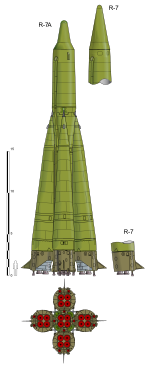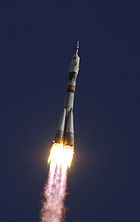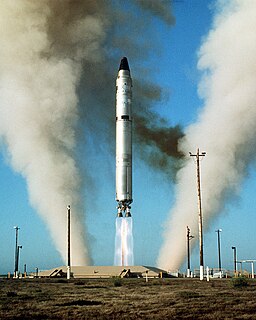
An intercontinental ballistic missile (ICBM) is a guided ballistic missile with a minimum range of 5,500 kilometres (3,400 mi) primarily designed for nuclear weapons delivery. Similarly, conventional, chemical, and biological weapons can also be delivered with varying effectiveness, but have never been deployed on ICBMs. Most modern designs support multiple independently targetable reentry vehicles (MIRVs), allowing a single missile to carry several warheads, each of which can strike a different target. Russia, the United States, China, India, Iran and North Korea are the only countries that have operational ICBMs.

A submarine-launched ballistic missile (SLBM) is a ballistic missile capable of being launched from submarines. Modern variants usually deliver multiple independently targetable reentry vehicles (MIRVs) each of which carries a nuclear warhead and allows a single launched missile to strike several targets. Submarine-launched ballistic missiles operate in a different way from submarine-launched cruise missiles.

The R-7 was a Soviet missile developed during the Cold War, and the world's first intercontinental ballistic missile. The R-7 made 28 launches between 1957 and 1961, but was never deployed operationally. A derivative, the R-7A, was deployed from 1959 to 1968. To the West it was known by the NATO reporting name SS-6 Sapwood and within the Soviet Union by the GRAU index 8K71. In modified form, it launched Sputnik 1, the first artificial satellite, into orbit, and became the basis for the R-7 family which includes Sputnik, Luna, Molniya, Vostok, and Voskhod space launchers, as well as later Soyuz variants.
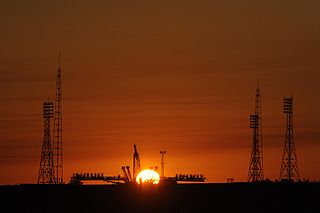
The Baikonur Cosmodrome is a spaceport located in an area of southern Kazakhstan leased to Russia.

Plesetsk Cosmodrome is a Russian spaceport located in Mirny, Arkhangelsk Oblast, about 800 km north of Moscow and approximately 200 km south of Arkhangelsk, dates from 1957. Originally developed as an ICBM site for the R-7 missile, it also served for numerous satellite launches using the R-7 and other rockets. Its high latitude makes it useful only for certain types of launches, especially the Molniya orbits, so for much of the site's history it functioned as a secondary location, with most orbital launches taking place from Baikonur, in the Kazakh SSR. With the end of the Soviet Union, Baikonur became a foreign territory, and Kazakhstan charged $115 million usage fees annually. Consequently, Plesetsk has seen considerably more activity since the 2000s.
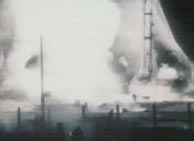
The Nedelin catastrophe or Nedelin disaster was a launch pad accident that occurred on 24 October 1960 at Baikonur test range, during the development of the Soviet ICBM R-16. As a prototype of the missile was being prepared for a test flight, an explosion occurred when the second stage engine ignited accidentally, killing an unknown number of military and technical personnel working on the preparations. Despite the magnitude of the disaster, news of it was suppressed for many years and the Soviet government did not acknowledge the event until 1989. The disaster is named after Chief Marshal of Artillery Mitrofan Ivanovich Nedelin, who was killed in the explosion. As commanding officer of the Soviet Union's Strategic Rocket Forces, Nedelin was head of the R-16 development program.

The Strategic Missile Forces or Strategic Rocket Forces of the Russian Federation or RVSN RF are a military branch of the Russian Armed Forces that controls Russia's land-based intercontinental ballistic missiles (ICBMs). The RVSN was first formed in the Soviet Armed Forces, and when the USSR collapsed in December 1991, it effectively changed its name from the Soviet to the Russian Strategic Rocket Forces or Strategic Missile Troops.
The R-16 was the first successful intercontinental ballistic missile deployed by the Soviet Union. In the West it was known by the NATO reporting name SS-7 Saddler, and within Russia, it carried the GRAU index 8K64.

The R-36 is a family of intercontinental ballistic missiles (ICBMs) and space launch vehicles (Tsyklon) designed by the Soviet Union during the Cold War. The original R-36 was deployed under the GRAU index 8K67 and was given the NATO reporting name SS-9 Scarp. It was able to carry three warheads and was the first Soviet MIRV missile. The later version, the R-36M was produced under the GRAU designations 15A14 and 15A18 and was given the NATO reporting name SS-18 Satan. This missile was viewed by certain United States analysts as giving the Soviet Union first strike advantage over the U.S., particularly because of its rapid silo-reload ability, very heavy throw weight and extremely large number of re-entry vehicles. Some versions of the R-36M were deployed with 10 warheads and up to 40 penetration aids and the missile's high throw-weight made it theoretically capable of carrying more warheads or penetration aids. Contemporary U.S. missiles, such as the Minuteman III, carried up to three warheads at most.

The RT-2PM Topol is a mobile intercontinental ballistic missile designed in the Soviet Union and in service with Russia's Strategic Missile Troops. By the early 2020s, all SS-25 ICBMs will be replaced by versions of Topol-M.

The R-9 was a two-stage ICBM of the Soviet Union, in service from 1964 to 1976.

The R-14 Chusovaya was a single stage Intermediate-range ballistic missile developed by the Soviet Union during the Cold War. It was given the NATO reporting name SS-5 Skean and was known by GRAU index 8K65. It was designed by Mikhail Yangel. Chusovaya is the name of a river in Russia. Line production was undertaken by Facility No. 1001 in Krasnoyarsk.

The R-12 was a theatre ballistic missile developed and deployed by the Soviet Union during the Cold War. Its GRAU designation was 8K63, and it was given the NATO reporting name of SS-4 Sandal. The R-12 rocket provided the Soviet Union with the capability to attack targets at medium ranges with a megaton-class thermonuclear warhead and constituted the bulk of the Soviet offensive missile threat to Western Europe. Deployments of the R-12 missile in Cuba caused the Cuban Missile Crisis in 1962. A total of 2335 missiles were produced; all were destroyed in 1993 under the Soviet and US Arms Control Treaty.
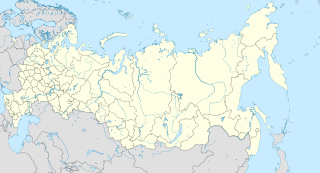
Kura Missile Test Range, originally known as Kama, is a Russian intercontinental ballistic missile impact area located in northern Kamchatka Krai in the Russian Far East. It is the destination for ballistic missiles which are test fired from other centers, and was chosen due to its remoteness and distance. It is 130 kilometers (81 mi) northeast of the settlement of Klyuchi and the military townlet is called Klyuchi-1, after the nearest settlement.

The RS-24 Yars - modification 24) also known as RT-24 Yars or Topol'-MR is a Russian MIRV-equipped, thermonuclear armed intercontinental ballistic missile first tested on May 29, 2007, after a secret military R&D project, to replace the older R-36 and UR-100N that have been in use for nearly 50 years.

The R-7 family of rockets is a series of rockets, derived from the Soviet R-7 Semyorka, the world's first ICBM. More R-7 rockets have been launched than any other family of large rockets.
Site 41, also known as Lesobaza and SK-1, was a launch complex at the Plesetsk Cosmodrome in Russia. It consisted of a single pad, Site 41/1, and was used by R-7 derived rockets between 1959 and 1989.
Site 16, also known as SK-2, is a launch complex at the Plesetsk Cosmodrome in Russia. It consists of a single pad, Site 16/2, and has been used by R-7 derived rockets since 1960.

Site 43, also known as SK-3 and SK-4, is a launch complex at the Plesetsk Cosmodrome in Russia. It consists of a two pads, Sites 43/3 and 43/4, and has been used by R-7 derived rockets since the early 1960s.

Site 41 was a complex of three launch pads at the Baikonur Cosmodrome originally built for flight testing of Intercontinental ballistic missile (ICBMs) using storable propellant. The need to develop such missiles was determined by low-tactical-technical and operational characteristics of the first Soviet ICBM R-7 created by the OKB-1 under the guidance of Sergei Pavlovich Korolev. May 13, 1959 by a special decree of the Central Committee of the CPSU and the CM of the design Bureau «Yuzhnoye» assigned to develop an Intercontinental ballistic missile on storable components of propellant, which has received designation R-16 and index – 8К64. Together with 41 platform built platform No. 42 – technical and No. 43 – for residing of serving military personnel and representatives of the industry.
